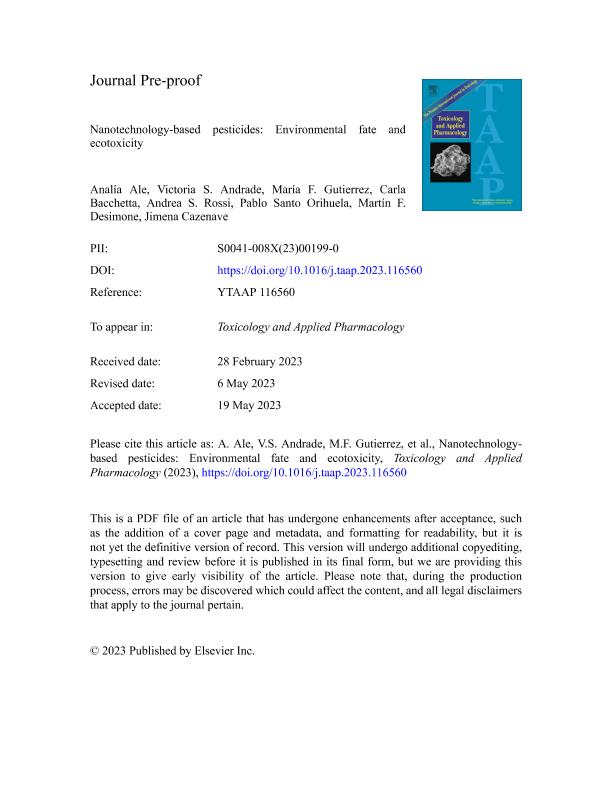Mostrar el registro sencillo del ítem
dc.contributor.author
Ale, Analía

dc.contributor.author
Andrade, Victoria Soledad

dc.contributor.author
Gutierrez, Marìa Florencia

dc.contributor.author
Bacchetta, Carla

dc.contributor.author
Rossi, Andrea Silvana

dc.contributor.author
Santo Orihuela, Pablo Luis

dc.contributor.author
Desimone, Martín Federico

dc.contributor.author
Cazenave, Jimena

dc.date.available
2024-02-06T13:36:19Z
dc.date.issued
2023-07
dc.identifier.citation
Ale, Analía; Andrade, Victoria Soledad; Gutierrez, Marìa Florencia; Bacchetta, Carla; Rossi, Andrea Silvana; et al.; Nanotechnology-based pesticides: Environmental fate and ecotoxicity; Academic Press Inc Elsevier Science; Toxicology and Applied Pharmacology; 471; 7-2023; 1-41
dc.identifier.issn
0041-008X
dc.identifier.uri
http://hdl.handle.net/11336/225945
dc.description.abstract
The imminent increase in global food demand inevitably leads to an increase in agricultural practices, with an emphasis on pesticide applications. Nanotechnology-based pesticides, or nanopesticides, have gained importance as they are more efficient and, in some cases, less toxic than their conventional counterparts. However, concerns about these novel products have arisen as evidence about their (eco)safety is controversial. This review aims to: (1) introduce the currently applied nanotechnology-based pesticides and their mechanisms of toxic action; (2) describe their fate when released into the environment, with an emphasis on aquatic environments; (3) summarize available research on ecotoxicological studies in freshwater non-target organisms through a bibliometric analysis; and (4) identify gaps in knowledge from an ecotoxicological perspective. Our results show that the environmental fate of nanopesticides is poorly studied and depends on both intrinsic and external factors. There is also a need for comparative research into their ecotoxicity between conventional pesticide formulations and their nano-based counterparts. Among the few available studies, most considered fish species as test organisms, compared to algae and invertebrates. Overall, these new materials generate toxic effects on non-target organisms and threaten the integrity of the environment. Therefore, deepening the understanding of their ecotoxicity is crucial.
dc.format
application/pdf
dc.language.iso
eng
dc.publisher
Academic Press Inc Elsevier Science

dc.rights
info:eu-repo/semantics/openAccess
dc.rights.uri
https://creativecommons.org/licenses/by-nc-sa/2.5/ar/
dc.subject
ALGAE
dc.subject
BIBLIOMETRIC ANALYSIS
dc.subject
ECOTOXICITY
dc.subject
FISH
dc.subject
INVERTEBRATES
dc.subject
NANOPESTICIDES
dc.subject.classification
Otras Ciencias de la Tierra y relacionadas con el Medio Ambiente

dc.subject.classification
Ciencias de la Tierra y relacionadas con el Medio Ambiente

dc.subject.classification
CIENCIAS NATURALES Y EXACTAS

dc.title
Nanotechnology-based pesticides: Environmental fate and ecotoxicity
dc.type
info:eu-repo/semantics/article
dc.type
info:ar-repo/semantics/artículo
dc.type
info:eu-repo/semantics/publishedVersion
dc.date.updated
2024-02-06T11:04:54Z
dc.journal.volume
471
dc.journal.pagination
1-41
dc.journal.pais
Estados Unidos

dc.description.fil
Fil: Ale, Analía. Consejo Nacional de Investigaciones Científicas y Técnicas. Centro Científico Tecnológico Conicet - Santa Fe. Instituto Nacional de Limnología. Universidad Nacional del Litoral. Instituto Nacional de Limnología; Argentina
dc.description.fil
Fil: Andrade, Victoria Soledad. Consejo Nacional de Investigaciones Científicas y Técnicas. Centro Científico Tecnológico Conicet - Santa Fe. Instituto Nacional de Limnología. Universidad Nacional del Litoral. Instituto Nacional de Limnología; Argentina
dc.description.fil
Fil: Gutierrez, Marìa Florencia. Consejo Nacional de Investigaciones Científicas y Técnicas. Centro Científico Tecnológico Conicet - Santa Fe. Instituto Nacional de Limnología. Universidad Nacional del Litoral. Instituto Nacional de Limnología; Argentina
dc.description.fil
Fil: Bacchetta, Carla. Consejo Nacional de Investigaciones Científicas y Técnicas. Centro Científico Tecnológico Conicet - Santa Fe. Instituto Nacional de Limnología. Universidad Nacional del Litoral. Instituto Nacional de Limnología; Argentina
dc.description.fil
Fil: Rossi, Andrea Silvana. Consejo Nacional de Investigaciones Científicas y Técnicas. Centro Científico Tecnológico Conicet - Santa Fe. Instituto Nacional de Limnología. Universidad Nacional del Litoral. Instituto Nacional de Limnología; Argentina
dc.description.fil
Fil: Santo Orihuela, Pablo Luis. Consejo Nacional de Investigaciones Científicas y Técnicas. Oficina de Coordinación Administrativa Houssay. Instituto de Química y Metabolismo del Fármaco. Universidad de Buenos Aires. Facultad de Farmacia y Bioquímica. Instituto de Química y Metabolismo del Fármaco; Argentina
dc.description.fil
Fil: Desimone, Martín Federico. Consejo Nacional de Investigaciones Científicas y Técnicas. Instituto de Investigaciones Científicas y Técnicas para la Defensa. Centro de Investigación de Plagas e Insecticidas; Argentina
dc.description.fil
Fil: Cazenave, Jimena. Consejo Nacional de Investigaciones Científicas y Técnicas. Centro Científico Tecnológico Conicet - Santa Fe. Instituto Nacional de Limnología. Universidad Nacional del Litoral. Instituto Nacional de Limnología; Argentina
dc.journal.title
Toxicology and Applied Pharmacology

dc.relation.alternativeid
info:eu-repo/semantics/altIdentifier/url/https://linkinghub.elsevier.com/retrieve/pii/S0041008X23001990
dc.relation.alternativeid
info:eu-repo/semantics/altIdentifier/doi/http://dx.doi.org/10.1016/j.taap.2023.116560
Archivos asociados
